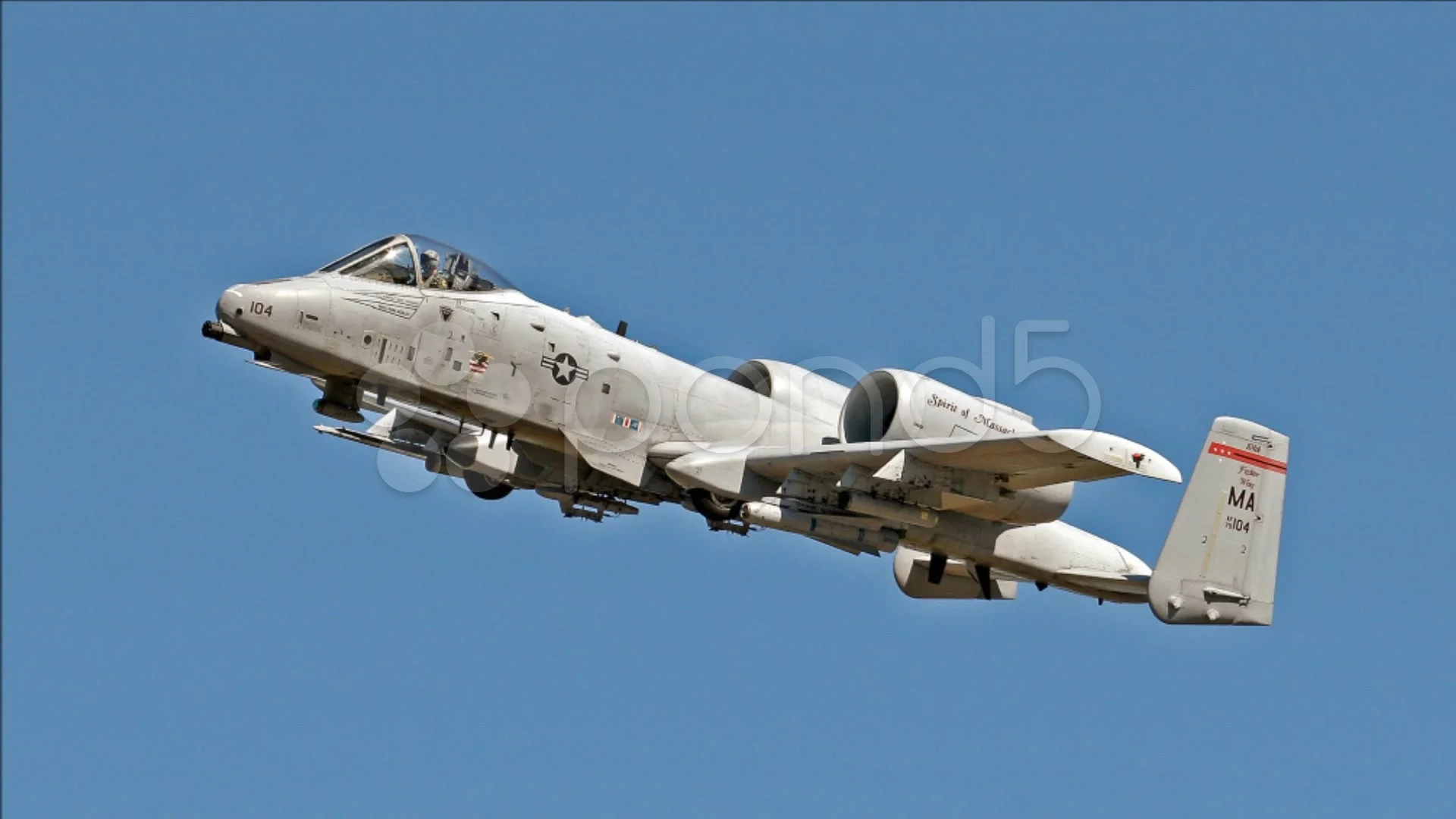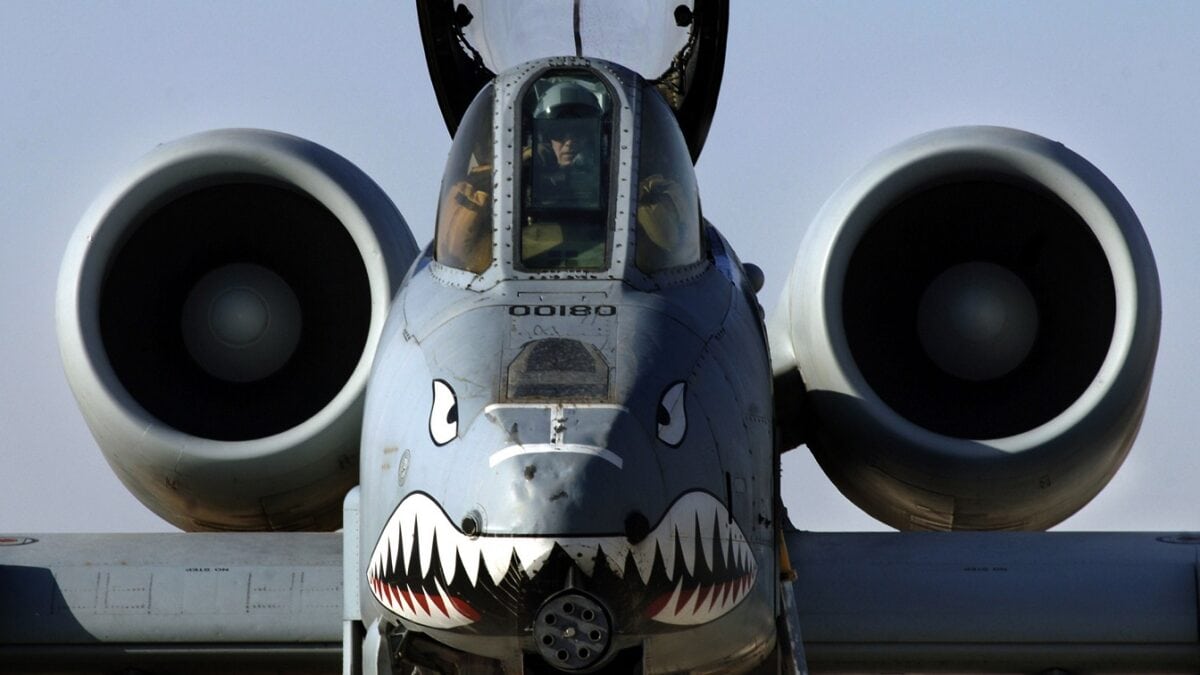A10 Warthog Video - The Fairchild Republic A-10 Thunderbolt II is a single-seat, twin-turbofan, straight-wing subsonic attack aircraft developed by Fairchild Republic for the United States Air Force (USAF). In service since 1976, it is named after the Republic P-47 Thunderbolt, a World War II-era fighter-bomber that was effective against ground targets, but is commonly referred to as the "Warthog" or simply the "Hog."
The A-10 was designed to provide close air support (CAS) to armed ground forces, attacking armored vehicles, tanks, and other enemy ground forces; it is the only production aircraft designed exclusively for CAS to serve in the United States Air Force.
A10 Warthog Video

Its secondary mission is to direct other aircraft in attacks on ground targets, a role known as forward air traffic controllers; Aircraft primarily used for this role are designated OA-10.
Yo Air Force: Don't You Dare Kill Off Our Toughest Warplane
The A-10 was designed to improve the characteristics and firepower of the Douglas A-1 Skyraider. His aircraft was designed for durability, measuring as much as 1,200 pounds (540 kg) of titanium armor to protect the cockpit and aircraft systems, allowing it to absorb damage and continue flying. Its ability to take off and land from relatively short runways allows it to operate from airstrips close to the front line, and its simple design allows maintenance to be performed with minimal amenities.
The A-10 participated in the Persian Gulf War (Operation Desert Storm), led by the United States against the Iraqi invasion of Kuwait, where the aircraft distinguished itself. The A-10 has also been involved in other conflicts such as Grada, the Balkans, Afghanistan, Iraq and against the Islamic State in the Middle East.
The single-seat A-10A variant was the only version produced, although the pre-production aircraft was modified to a two-seat YA-10B prototype to test an all-weather and night-time version. In 2005, a program was initiated to upgrade the remaining A-10As to the A-10C configuration with modern avionics for use with precision weapons. The US Air Force has said the Lockheed Martin F-35 Lightning II will replace the A-10 as it has been in service, but it is still very much a question in the US Air Force and in political circles. With the help of various upgrades and wing replacements, the service life of the A-10 can be extended to 2040; the position has no scheduled retirement date in June 2017
During the Vietnam War, the 1940s-vintage Skyraider was the USAF's only short-range special purpose aircraft. It was slow, sensitive to ground fire, and relatively lightly armed.
A 10 Thunderbolt Images, Stock Photos & Vectors
As tactical aviation development efforts focused on delivering nuclear weapons using high-speed designs such as the McDonnell F-101 Voodoo and the Republic F-105 Thunderchief.
When the US Army was involved in the Vietnam War, its main attack aircraft was the Douglas A-1 Skyraider from the Korean War. A powerful aircraft for its time, with a relatively large payload and long hover time, the propeller was relatively slow and susceptible to ground fire. The US Air Force and Navy lost 266 A-1s in combat in Vietnam, mostly to small arms fire.
On June 7, 1961, Secretary of Defense Robert McNamara ordered the US Air Force to develop two tactical aircraft, one for long-range strike and interception and the other focused on the fighter-bomber. The first was the Experimental Tactical Fighter (TFX), a joint development between the US Air Force and the US Navy,

Which appeared as the Geral Dynamics F-111 Aardvark and the other was filled by the US Navy version of the McDonnell Douglas F-4 Phantom II. Although the Phantom wt became one of the most successful fighters of the 1960s and proved capable as a fighter-bomber, its lack of hang time was a major problem, and to a lesser extent its poor low-speed performance. It was also expensive to purchase and operate, costing US$2 million to fly in fiscal year 1965 ($17.2 million today) and operating costs exceeding US$900 per hour ($8,000 per hour today).
Video Animation Shows How 107th Fs A 10 Warthog Brrrrtttted A Cow During A Cas Sortie
After a broad review of the tactical structure of the US Air Force, the US Air Force decided to adopt an inexpensive aircraft to complement the F-4 and F-111. He initially focused on the Northrop F-5, which had air-to-air capability.
A 1965 cost-effectiveness study shifted focus from the F-5 to the less distinctive A-7D LTV A-7 Corsair II variant, and the contract was awarded. But this aircraft doubled in price due to the requirement of an upgraded engine and new avionics.
The Lockheed AH-56 Cheyne seemed to provide an opportunity to leave much of the US Army's tactical air-to-ground role.
During this period, the US Army introduced the Bell UH-1 Iroquois. It was originally used as a transport helicopter, but was soon modified to carry more machine guns in what became known as a combat helicopter. This proved effective against a lightly armed opponent, and new cannons and missile pods were added. The Bell AH-1 Cobra was soon introduced. It was an attack helicopter armed with long-range BGM-71 TOW missiles capable of destroying tanks outside the defensive fire range. The helicopter was effective and forced the US military to change its defense strategy in Europe to blunt any Warsaw Pact advance with anti-tank helicopters instead of the tactical nuclear weapons that had been the mainstay of NATO's battle plans since the 1950s.
This Video Shows Why The A 10 Warthog Is Still A Great Attack Aircraft
The Cobra was a rapidly built helicopter based on the UH-1 Iroquois and was introduced in the mid-1960s as an interim project until the US Army launched the Advanced Aerial Fire Support System program. For initial production, the Army chose the Lockheed AH-56 Cheyne, a much more powerful attack aircraft with a higher speed. These developments alarmed the US Air Force, which saw the anti-tank helicopter overtaking nuclear tactical aircraft as the primary anti-tank force in Europe.
A 1966 Air Force study of existing close air support (CAS) capabilities identified gaps in escort and fire suppression roles that Cheyne could fill. The study concluded that the service should acquire a simple, low-cost, dedicated CAS aircraft at least as powerful as the A-1, and that it should develop doctrine, tactics, and procedures for such aircraft to perform the missions for which attack helicopters were designed . is provided
On September 8, 1966, Gerald John P. McConnell, Chief of Staff of the United States Air Force, ordered the design, development, and acquisition of a specialized CAS aircraft. On 22 December, an action guidance request was issued for the A-X CAS aircraft,

On March 6, 1967, the BBC issued a request for information to 21 defense contractors for the A-X.
Believe It Or Not, The A 10 Can Hold Its Own In A Dogfight
In May 1970, the US Air Force issued a modified, more detailed request for proposals for the aircraft. The threat from Soviet armored forces and all-weather offensives intensified. Requirements now included that the aircraft be designed specifically for the 30 mm swivel gun. The RFP also listed a top speed of 460 mph (400 knots; 740 km/h), a takeoff range of 4,000 ft (1,200 m), an external payload of 16,000 lb (7,300 kg), a range of 285 mi (460 km) . radius and a unit cost of US$1.4 million ($9.8 million today).
During this time, a separate RFP was issued for the 30 mm A-X gun, which required a high rate of fire (4,000 rounds per minute) and a high muzzle velocity.
Six companies submitted proposals for the aircraft, with Northrop and Fairchild Republic selected to build the prototypes: the YA-9A and YA-10A, respectively. The companies Geral Electric and Philco-Ford were chosen to create and test prototypes of the GAU-8 gun.
Two YA-10 prototypes were built at the Republic factory in Farmingdale, New York, and first flew on May 10, 1972, by pilot Howard "Sam" Nelson. The production A-10 was built by Fairchild in Hagerstown, Maryland. After testing and transitioning to the YA-9, on January 18, 1973, the USAF announced the selection of the YA-10 for production.
This Is How You Make An A 10 Warthog Out Of Legos
In 1974, the YA-10 flew an additional sortie against the Ling-Temco-Vought A-7D Corsair II, the US Air Force's primary attack aircraft at the time, to prove the need for a new attack aircraft. The first production A-10 flew in October 1975, and deliveries began in March 1976.
The N/AW was developed by Fairchild based on the first Demonstration Test and Evaluation (DT&E) of the A-10 for consideration by the USAF. It included a second seat for the weapons systems officer responsible for electronic countermeasures (ECM), navigation and target acquisition. The N/AW version did not interest the US Air Force or export customers. A two-seat version of the simulator was ordered by the Air Force in 1981, but the US Congress cut off funding and the simulator was never built.
On February 10, 1976, US Deputy Secretary of Defense Bill Klemt authorized full-scale production, with the first A-10 being accepted by the Air Force Tactical Aviation Command on March 30, 1976. Production continued, reaching a maximum rate of 13 aircraft per month. By 1984, 715 aircraft had been delivered, including two prototypes and six experimental aircraft.
/https://tf-cmsv2-smithsonianmag-media.s3.amazonaws.com/filer/c5/ad/c5ad1459-0a4d-4d71-a3ab-8c49b8ef2877/17d_aug2020_karlafghanistan2_2018_2_live.jpg)
When the A-10 was first approved for full-speed production, the aircraft had a planned life of 6,000 hours. A slight structural strengthening was quickly adopted when the A-10 failed initial fatigue tests in 80% of the tests; with correction A-10 passed the fatigue test. At that time, 8,000 flight hours had become commonplace, so A-10 fatigue testing continued with a new target of 8,000 hours. This new target quickly revealed serious cracks in Wing Station 23 (WS23).
A 10 Warthog
A10 warthog lego set, a10 warthog rc plane, a10 warthog shot glass, a10 warthog, a10 warthog toy, rc a10 warthog rtf, a10 warthog rc, a10 warthog poster, a10 warthog t shirts, a10 warthog hotas, thrustmaster a10 warthog, a10 warthog gun video
0 Comments